Small pectoral muscle - a source of pain that you do not know about
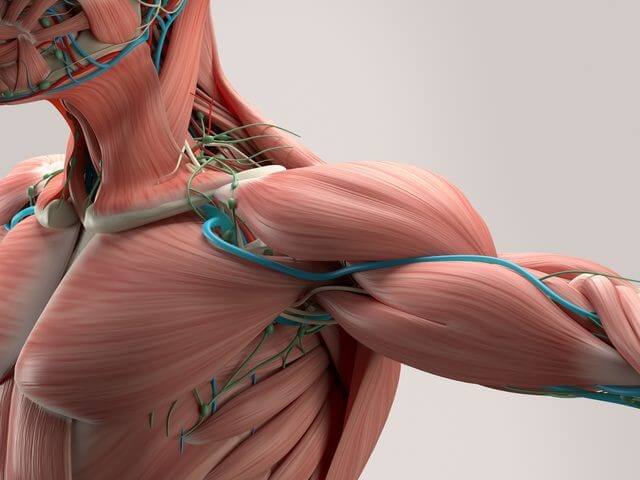
The small pectoral muscle is the "smaller sister" of the more massive and known large pectoral muscle. It's not strange, but even a muscle of such small size can cause serious problems. It is located under the large pectoral muscle, it extends from the 3rd, 4th and 5th ribs, extends laterally upwards and is attached to the coracoid process of the scapula.
Functions of a small pectoral muscle: stabilization of the scapula, as well as its lowering, pulling and turning down. When the scapula is in a fixed position, this muscle also takes part in lifting the chest.
After explaining the functions of pectoralis minor , we will understand what problems may be associated with it.
Condition of small pectoral muscle and posture disorders
Small pectoralis muscle is a rather weighty factor in the formation of correct (or incorrect) posture. One of the functions of pectoralis minor is pulling the scapula - moving it forward, from the spine, and around the chest, which leads to stooping in the shoulders.
Unfortunately, in the lives of most of us, a sedentary lifestyle prevails - most of the time we spend on computers, driving, bending over the desk in unnatural poses, when our shoulders are rounded and tilted forward, the back is hunched. This position over time inevitably leads to overstrain of the small pectoral muscle (the appearance of muscle nodes, or clamps).
Disorders of posture - though a big, but not the only, problem caused by overexertion of the small pectoral muscle. Therefore, we consider the following reasons below:
- What symptoms and problems appear when overexerting pectoralis minor ;
- What is the syndrome of the small pectoralis muscle;
- How to get rid of the pain caused by overexertion of the small pectoral muscle.
Overexertion of small pectoralis muscle: starting point for serious disorders
Overloaded small pectoral muscle significantly affects the function of the shoulder joint and increases the risk of injury.
Perhaps the most common problem associated with pectoralis minor is subacromial imidation syndrome .
In this case, a lack of space in the area between the humerus and the shoulder-bone (acromion) leads to the entrapment of the tendons of the supraspinatus and the subacromial sac, especially when the arm is raised above the shoulder, and also during rotational movements.
Pinched tendons, nerves and vessels in the shoulder and chest - the effects of overstrain of the small pectoral muscle.
Such a lack of space can be directly related to the overstrained small pectoral muscle due to the inclination of the scapula forward and the reduction of the subacromial arch.
In this case, patients complain about :
- Dull pain in the shoulder;
- Increased pain when lifting hands up;
- Problems with sleeping as a result of pain syndrome, especially when lying on the affected side;
- A characteristic sound of crunching or clicking during the lowering of the hand;
- Limitation of joint mobility;
- Weakness in the hand.
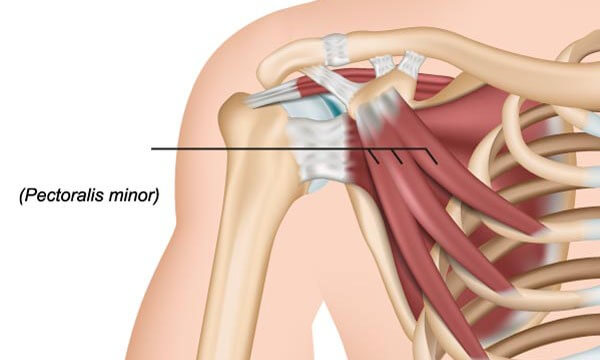
In addition to increasing the risk of pinching, the over-strained small pectoral muscle, together with the anterior cog muscle, translates the articular fovea of the scapula to a more upright position, which leads to increased retraction, rotation, and pterygoid scapula.
Due to the change in the position of the scapula, the muscle that lifts the scapula and the upper fibers of the trapezius muscle begin to strain intensively in an attempt to stabilize its position. Ultimately, this leads to overstrain of the muscles of the neck and shoulders and the appearance of many trigger points in this area, which is typical for many working at the table (well, or on the couch, with the laptop on its lap).
Pain in the shoulder, numbness of the hand, tingling in the upper limbs, and trigger points of the muscles of the neck and back are consequences of the overstrain of the small pectoral muscle.
The syndrome of a small pectoral muscle - when nerves and blood vessels suffer
In 50% of cases, it is the small pectoral muscle that is the primary cause of the compression syndrome of the chest aperture (or simply the small pectoralis syndrome). What it is?
The syndrome of small pectoral muscle manifests itself by compression of the nerves and blood vessels located in the anterior part of the shoulder and thorax - the humerus plexus, the subclavian artery and the vein. Pinched nerves and blood vessels necessarily make themselves felt, causing considerable physical discomfort.
Symptoms of this syndrome vary depending on the location and degree of compression of the neuromuscular bundle and can be manifested as:
- Painful sensations all over the arm - from the shoulder to the little finger;
- Numbness, decreased sensitivity, tingling in the limb;
- Weakness in the hand;
- Blushing of the upper limb;
- A decrease in the temperature of the hand;
- Increased pain during movement.
As you can see, a small pectoral muscle, or more precisely, its overstrain, can cause problems that cover the area of the shoulder joint, neck and arms. But this is only part of the whole picture: as a result of muscle compensation that passes along the kinetic chain, the negative effect of the overstrain of the small pectoral muscle can affect even the lower back and the pelvic region.
How to relax a small pectoral muscle: stretching and massage of trigger points
The following figure shows the location of the trigger points of the small pectoral muscle and the scheme of reflected pain when these points are pressed:

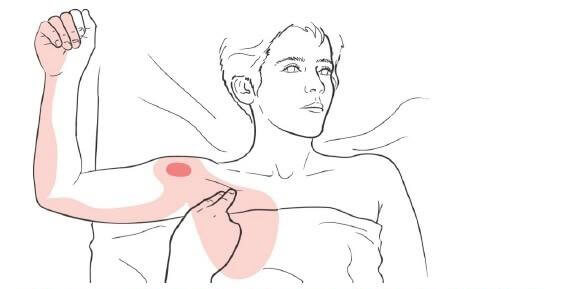
Fortunately, the small pectoral muscle reacts well to therapy - massage and / or stretching. However, it should be noted that it is not so easy to deal with an overstretched chest muscle independently, we recommend either contact a specialist (which is certainly better) or ask a friend / spouse / relative for help.
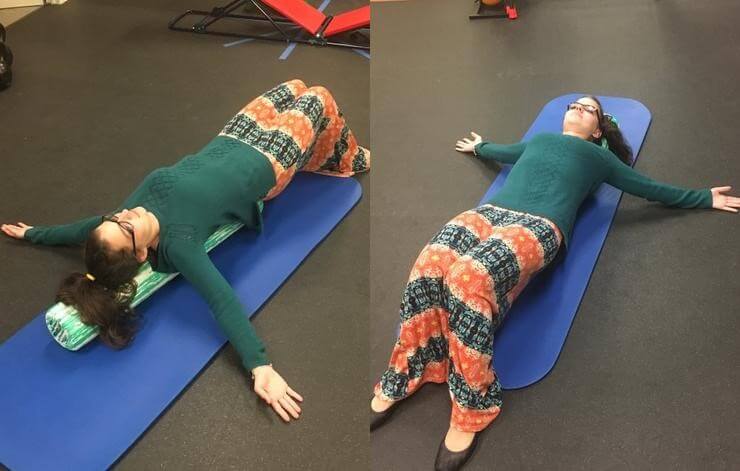
Stretching to eliminate trigger points of the pectoralis muscle:
- Lie down on a cylindrical object (a special roller or a tightly twisted blanket or towel) so that it is on the line of the spine. In this position, lower your shoulders down towards the floor, relax, feel the relaxation in the front of the shoulder and upper chest. The hands can first be placed along the trunk, and then diluted at an angle of 80, 120 and 160 degrees.
- Sit on the floor and ask the assistant to stand behind you. Take both hands back and ask the assistant to gently, gently and with a little strength to take his hands even further.
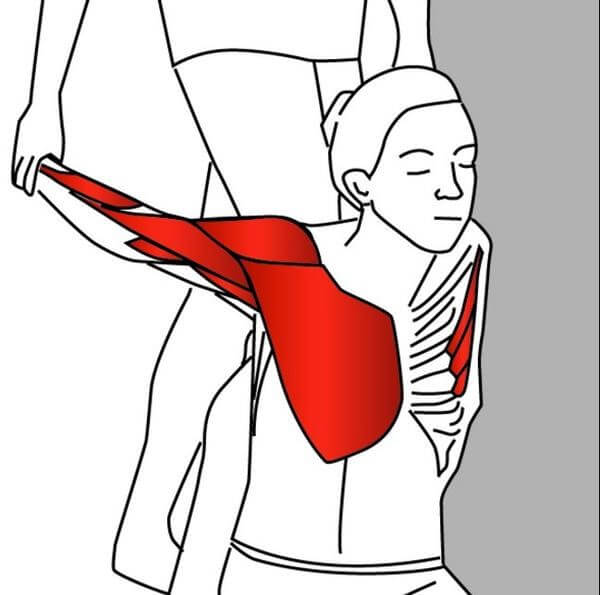
Massage of trigger points of a small pectoral muscle: to perform a massage of a small pectoral muscle, it is better to consult a specialist who can correctly determine the location of the trigger points and effectively affect them. At home, massage can be done using a tennis ball in a prone position (putting the ball on the floor) or standing (holding the ball between the wall and a small pectoralis muscle) as in the pictures:

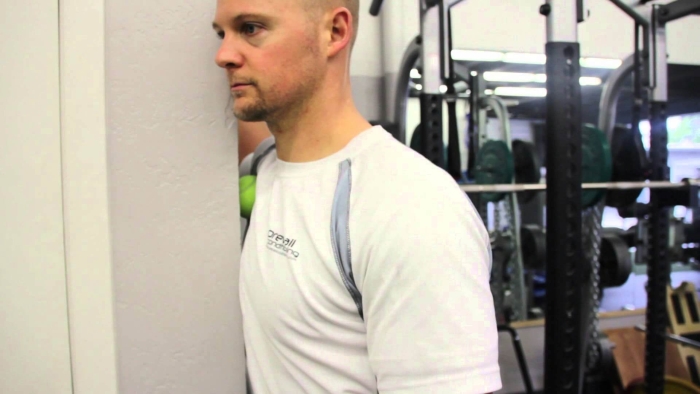
In addition to stretching and massage, try to perform exercises aimed at strengthening the muscles-antagonists of the small pectoral muscle. Focus on the middle and lower parts of the trapezius muscle, rhomboid, pay attention to the anterior dentate, subacute muscle, and also the rear deltas.
The best method to deal with problems caused by overexertion of the small pectoral muscle is to prevent them - proper posture and maintaining the tone of all the muscles of the body - a pledge of not only a beautiful figure, but also an excellent state of health.
Via estet-portal.com


Comments
When commenting on, remember that the content and tone of your message can hurt the feelings of real people, show respect and tolerance to your interlocutors even if you do not share their opinion, your behavior in the conditions of freedom of expression and anonymity provided by the Internet, changes Not only virtual, but also the real world. All comments are hidden from the index, spam is controlled.